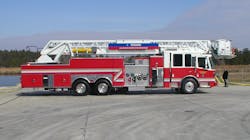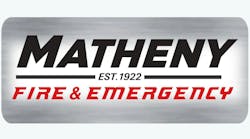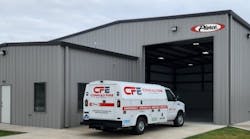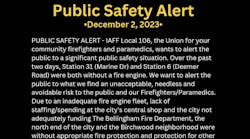Purchasing fire apparatus can feel like a daunting task that involves many moving parts and an excruciating number of details. Fortunately, learning from those who have been through the experience firsthand is a great way to avoid the common pitfalls and challenges associated with this complex process.
There are several goals of acquiring new apparatus:
• Replace an aging apparatus
• Modernize fire department fleet
• Increase operator/occupant safety
• Acquire features and functions not available on older apparatus
• Increase reliability/reduce downtime
• Reduce annual operating costs
Regardless of your reasoning for acquiring a new apparatus, there are several factors to consider throughout the process.
Competitive bidding
An open and competitive bidding process is important to ensure that the department purchases quality apparatus that meets its needs at the best price. There are several challenges to the competitive bid process, the first being the creation of a specification document. A good specification document is extensive, complex and detailed. Who from the fire department is qualified to prepare this document? Many departments opt to use a manufacturer-supplied document that can create the appearance of a preference for a certain product, which can, in turn, limit bid responses. Limited bid responses may lead to higher prices. Make it clear to the representatives from the different manufacturers in your prospective bidding pool that the fire department will be purchasing the apparatus from the lowest responsible bidder; this will help with receiving multiple bids.
Apparatus committee
The apparatus committee should represent a cross-section of the fire department membership. The committee chair should be someone who can serve as a consensus-builder and make key decisions, changes or overrides if it becomes necessary. Being a member of an apparatus committee is a big commitment in both time and energy, with some travel involved. Department members who want to serve on an apparatus committee must understand this, and those who cannot or will not make the commitment should not be on the committee. An apparatus committee should have a maximum of six members. Large apparatus committees have difficulty in reaching consensus on items—and a lot of time gets wasted. The lack of progress becomes discouraging and members stop participating.
A fire department’s or committee members’ preference for a certain manufacturer’s product can affect the purchase process and apparatus cost. Stakeholders in the purchasing process must be careful not to show a preference toward a particular manufacturer.
Following are three things a fire department or apparatus committee should never do in the purchasing process:
1. Morph documents: Never morph two or more manufacturer-supplied documents into your bid specification. While there is a lot of commonality in apparatus from different manufacturers, all manufacturers have proprietary engineering and manufacturing. Morphing specifications from different manufacturers creates a specification for apparatus that cannot be properly bid or built. This creates many problems in the build process.
2. Use manufacturer language: Never use manufacturer supplied language for legal requirements, bond requirements, contract or warranty language. Make sure the legal language and requirements for these topics best serves the needs and expectations of the fire department.
3. Pre-pay: Never pre-pay any portion of the contract amount or for any portion of the apparatus without the appropriate bonds in place to protect the municipality. Make sure that the bond underwriter is highly rated by a third party. If you are paying for the cab and chassis assembly when it is completed, have the Manufacturer’s Statement of Origin issued to the fire department when payment is made.
Budgeting
The apparatus committee must have a definitive budget number. In every instance I have been involved in over the last five years where the committee was told to go get what they wanted without being given a budget number, the bids were rejected because of cost. Rejection of the bids usually means a specification rewrite. This equates to a tremendous amount of lost time. The committee’s work must be redone and the bidder’s work must be redone, leading to frustration on everyone’s part. This can also result in some bidders opting not to participate in the re-bid. The lost time can also lead to higher cost for the apparatus because of price increases. Conversely, in cases where the committee had defined budget numbers and stuck to them, the process from specification through delivery went smoothly, from a financial standpoint.
How far will your budget dollars go? There are many variables that play into this, and there is no exact formula that will answer this question, but research will give you the best idea. Talk to neighboring fire departments that recently purchased new apparatus. Review the details of their purchase and what they spent. Check trade publications and manufacturer websites for recently delivered apparatus similar to what you want to purchase. Review the apparatus features and prices. Attend a regional fire show or convention and look at the apparatus on display and what they cost. Finally, meet with apparatus sales representatives from various manufacturers, review your “want list” with them, and ask them for a cost estimate. Remember that the sales representative is giving you an estimate that is based on fairly minimal information; the final specification package is what will really determine the apparatus cost. For a general budget number, add 10 percent to the sales representative’s initial estimate.
Specifications
Ask yourself the following and write down your answers:
• What works and what does not work for current operations?
• What functions/features/components need to be carried forward to the new apparatus?
• What features/functions/components should not be carried forward to the new apparatus?
• What is lacking on the current apparatus that needs to be incorporated into the new apparatus?
Next, look at your fire protection district and consider how it has changed in the last 20 years. Then ask yourself:
• Is the population increasing or decreasing?
• How are the occupancies you protect changing? For example, are old buildings repurposed? Has a school or old factory been converted into residential? Has an industrial building been converted into commercial or vice versa?
• What new construction is taking place in the district? Are there new residential subdivisions, multi-family or commercial structures, schools, industrial facilities? Are any of these special hazards? Healthcare, hazmat, agriculture, lightweight and/or engineered wood
• What buildings have been demolished, occupancies abandoned, or locations cleaned and restored that no longer need a high level of fire protection?
• What is the local municipality or county’s master plan and the possible impacts of that plan on the fire department?
• What is the department’s current Insurance Services Office (ISO) rating? How does the current fleet meet the ISO standards? What effects does the ISO standard have on the design and specification of the new apparatus?
The single biggest mistake I see with planning and specifying new apparatus is members caught in the past—the “we’ve always done that” mindset. You are not answering the same type of calls you did 20 years ago: You’re not fighting the same type of fires, buildings aren’t constructed the same way, cars have ethanol, etc. You are designing a piece of equipment that your department will have for the next 20 or 25 years, so make sure it is designed to meet those needs, not yesterday’s.
Bid review
Once the specifications have been completed, sent out to bid and the bids have been opened, now it is time to conduct a bid review. Each bid submission must be reviewed to verify compliance with the specification package. A good bid review is time-consuming and will result in a lot of information to digest. The substitutions and clarifications listed in the documents supplied with the bid will NOT be the only ones. Read the bid submissions carefully. Have a highlighter and a notepad, and keep a detailed list. Any questions for bidders should be communicated via email or written channel where there is a record. If you speak on the phone, keep a log. It does not need to be an essay, but it should include date, time, who you spoke to, and topic.
Classify the substitutions and clarifications as major, minor or engineering-based.
• Major substitutions and clarifications have a significant impact on the safety, performance, longevity, operational characteristics or maintenance of the proposed apparatus or reflect a major component deficiency (i.e., specified a 15-kW generator but a 10-kW unit was bid).
• Minor substitutions or clarifications have no impact on one or more of the criteria referenced above and should usually be accepted as proposed. A review of these differences should be addressed with the bidder prior to any potential contract award.
• Engineering-based substitutions and clarifications are related to manufacturer-specific engineering, design and/or manufacturing processes. Provided that these variations do not have a significant impact on the safety, performance, longevity, operational characteristics or maintenance of the proposed apparatus, these should generally be accepted as proposed.
Most state purchasing laws allow non-compliant bidders to be disqualified, but a decision to disqualify a bidder may be challenged. Remember that this is a legal process, and you must be able to defend your decision to disqualify in the event of a challenge. A challenge traditionally comes from one of the bidders that was not successful; however, that has changed some. These days, a challenge is much more likely to come from a municipal official, civic group or a taxpayer. In some cases, it may be a member of the department, as was a recent challenge I went through.
Make your decision based on solid facts that address the operational, safety or longevity of the apparatus or items that clearly impact the cost. Decisions cannot be made based on minor items. Keep your notes, phone logs and written communications, and place them in the file with bidder’s submission. Do not dispose of the disqualified and/or unsuccessful bidder’s submission packages without checking your state’s public records law.
Pre-construction conference
Once all of the bid review questions are answered and the contract has been awarded, the next step in the process is the pre-construction conference. This is the single most important step in the apparatus build process. This stage allows for the fine-tuning of the apparatus build design and specifications and the time to make adjustments. Virtually every item and component of the apparatus, large and small, will be reviewed. Make sure that this meeting is given the time and attention to detail that it demands. Do NOT shortchange yourself on this step.
You will have the option to hold this meeting at the manufacturer’s factory, the dealership or fire department. Being at the factory gives the committee members a chance to see how things are done, and observations made at the factory can be very valuable while making decisions during the pre-construction conference. If held at the dealership or fire department, insist that an engineer from the factory is present.







